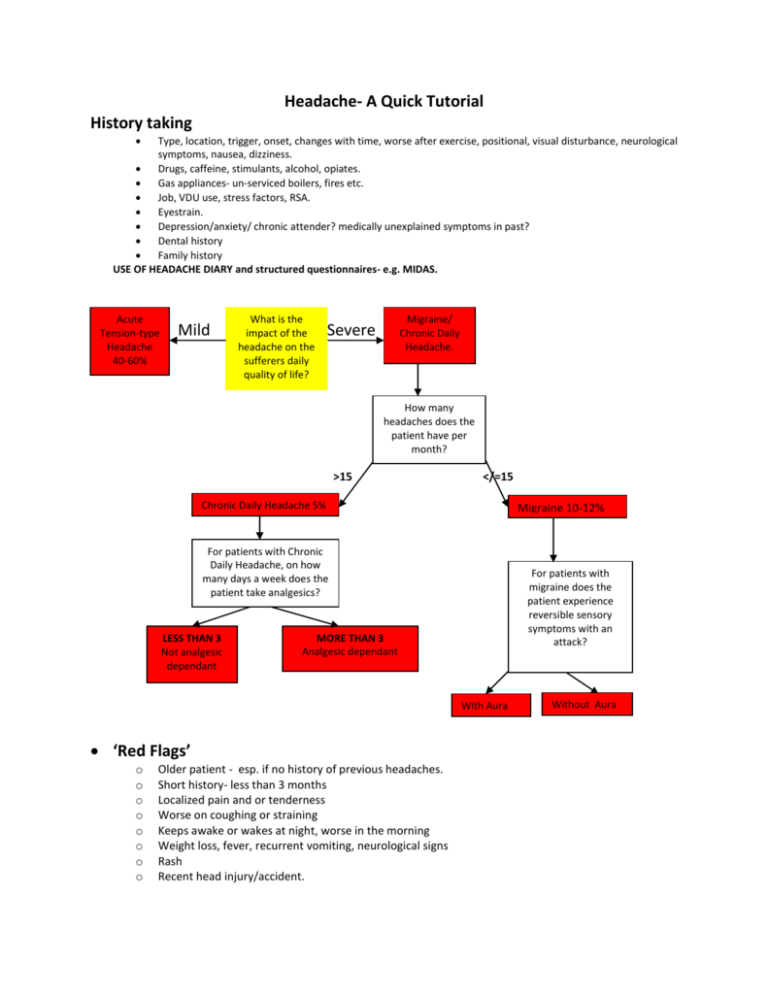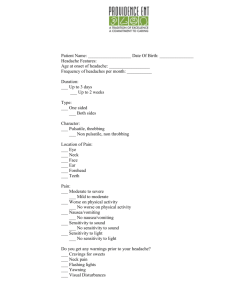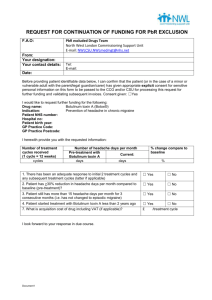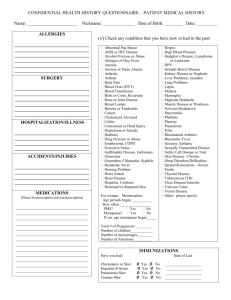Headache- A Tutorial
advertisement

Headache- A Quick Tutorial History taking Type, location, trigger, onset, changes with time, worse after exercise, positional, visual disturbance, neurological symptoms, nausea, dizziness. Drugs, caffeine, stimulants, alcohol, opiates. Gas appliances- un-serviced boilers, fires etc. Job, VDU use, stress factors, RSA. Eyestrain. Depression/anxiety/ chronic attender? medically unexplained symptoms in past? Dental history Family history USE OF HEADACHE DIARY and structured questionnaires- e.g. MIDAS. Acute Tension-type Headache 40-60% Mild What is the impact of the headache on the sufferers daily quality of life? Migraine/ Chronic Daily Headache. Severe How many headaches does the patient have per month? >15 </=15 Chronic Daily Headache 5% Migraine 10-12% For patients with Chronic Daily Headache, on how many days a week does the patient take analgesics? LESS THAN 3 Not analgesic dependant For patients with migraine does the patient experience reversible sensory symptoms with an attack? MORE THAN 3 Analgesic dependant With Aura ‘Red Flags’ o o o o o o o o Older patient - esp. if no history of previous headaches. Short history- less than 3 months Localized pain and or tenderness Worse on coughing or straining Keeps awake or wakes at night, worse in the morning Weight loss, fever, recurrent vomiting, neurological signs Rash Recent head injury/accident. Without Aura Salient points on examination Check Temp, BP, Pulse (indefensible not to), pupillary reflex and fundi, then 30 second neurological exam. (formulate own). Don’t forget TMJ’s/ Cervical spine/ Teeth/ Temporal Arteries/sinus tenderness/Mentaln state Diagnostic Criteria In 1988 the International Headache Society published criteria for the diagnosis of a number of different headache types [1]. Those for some of the common headaches are reproduced below for migraine with and without aura, cluster headache, tension-type headache, and cervicogenic headache. Migraine with aura diagnostic criteria A. At least two attacks fulfilling with at least three of the following: 1. One or more fully reversible aura symptoms indicating focal cerebral cortical and/or brain stem functions 2. At least one aura symptom develops gradually over more than four minutes, or two or more symptoms occur in succession 3. No aura symptom lasts more than 60 minutes; if more than one aura symptom is present, accepted duration is proportionally increased 4. Headache follows aura with free interval of at least 60 minutes (it may also simultaneously begin with the aura B. At least one of the following aura features establishes a diagnosis of migraine with aura: 1. Homonymous visual disturbance 2. Unilateral paresthesias and/or numbness Migraine without Aura diagnostic criteria A. At least five headache attacks lasting 4 - 72 hours (untreated or unsuccessfully treated), which has at least two of the four following characteristics: 1. Unilateral location 2. Pulsating quality 3. Moderate or severe intensity (inhibits or prohibits daily activities) 4. Aggravated by walking stairs or similar routine physical activity B. During headache at least one of the two following symptoms occur: 1. Phonophobia and photophobia 2. Nausea and/or vomiting 3. Unilateral weakness 4. Aphasia or unclassifiable speech difficulty Chronic Daily Headache See Above. Migrainous Neuralgia/Cluster diagnostic criteria A. At least five attacks of severe unilateral orbital, supraorbital and/or temporal pain lasting 15 to 180 minutes untreated, with one or more of the following signs occurring on the same side as the pain 1. Conjunctival injection 2. Lacrimation 3. Nasal congestion 4. Rhinorrhoea 5. Forehead and facial sweating 6. Miosis 7. Ptosis 8. Eyelid oedema B. Frequency of attacks from one every other day to eight per day Often migraine like- centred around/over one eye.. Very very severe can drive people to suicide or to want to bang their heads against a wall. Tend to occur daily around the same time. More common in men. Initial treatment- worth trying Carbamazepine. Table : Headache features in migraine compared with tension-type headache (from BANDOLIER) Likelihood ratios Symptoms Positive Negative LR+ 95% CI LR- 95% CI Nausea 19.2 15-25 0.20 0.19-0.21 Photophobia 5.8 5.1-6.6 0.25 0.24-0.26 Phonophobia 5.2 1.5-5.9 0.38 0.36-0.40 Activity makes it worse 3.7 3.4-4.0 0.24 0.23-0.26 Unilateral 3.7 3.4-3.9 0.43 0.41-0.44 Throbbing/pulsing 2.9 2.7-3.1 0.36 0.34-0.37 Treatment of migraine Acute Depends on whether in mild to moderate or moderate to severe category. If mild to moderate start with high dose aspirin (900mg stat if over 14 years of age) with prokinetic e.g. metoclopramide 10mg or domperidone. Can be repeated up to 3 times a day. If ineffective progress to a triptan- see below. If moderate to severe start immediately with a triptan, ideally oral sumatriptan as soon as possible after onset. Can be repeated within 24 hours once but not for the same attack. Triptans contraindicated in cerebro or cardio vascular disease. OK in first trimester of pregnancy but limited data. Avoid concurrent SSRI’s, St Jiohns Wort and MAOI’s. If initial treatment unsuccessful after 1 hour progress to an alternative, s/c admin. or nasal spray. Again if unsuccessful consider prophylaxis plus acute treatment for breakthrough headache. Prophylactic treatment only occurs in 3-5% of migraineurs Indications: 2 or more disabling headaches per month, ineffective symptomatic treatment, use of abortive medication more than twice a week, migraines with neurological sequelae First line Tricyclics, Betablockers, (note both unlicensed indications) Calcium channel blockers, antiinflammatories, anti-serotonin therapies (methysergide) and anticonvulsants (valproate has the best evidence for any drug). Second line ACE Inhibitors, Venlafaxine, gabapentin, topiramate, high dose riboflavin and magnesium supplements and the herbs “feverfew” and “petasites hybridus rhizome” Tailor treatment to other co-morbid factors- i.e. patients with symptoms of mild depression or insomnia may benefit from a Tricyclic, Major depression - Venlafaxine, asthmatics/young athletes/ erectile dysfunction try calcium channel blocker or ACE I over Beta blockers. Pregnant women- aggressive strategies focusing on lifestyle change, stress and trigger management. Tension A. Headache lasting from 30 minutes to seven days B. At least two of the following criteria: 1. Pressing/tightening (non-pulsatile) quality 2. Mild or moderate intensity (may inhibit, but does not prohibit activity 3. Bilateral location 4. No aggravation by walking, stairs or similar routine physical activity C. Both of the following: 1. No nausea or vomiting (anorexia may occur) 2. Photophobia and phonophobia are absent, or one but not both are present Exclude conditions that cause secondary tension headache e.g. TMJ dysfunction, sinus pain or eye muscle disorders. Explain condition is real not benign Explore sources of tension. Advise relaxation ex’s, YOGA, or time-out? Prescribe simple analgesia- avoid codeine based- e.g. Ibuprofen 400mg tds or Amitriptylline 25mg at night (10mg if elderly) increase to 75mg or Propranolol 10-40mg tds (esp. if anxiety present). Caffeine containing compounds are effective for the acute treatment of tension type headache. The number-needed-to-treat for a patient to achieve at least 50% pain relief at four hours is about 5 for both aspirin 500 mg/paracetamol 500 mg/caffeine 130 mg and paracetamol 1000 mg/caffeine 130 mg (From Bandolier June 1994). Analgesic Headache Likely if taking analgesics daily especially if codeine/benzodiazepine/dextropropoxyphene based (coprox). Ergotamine also a culprit hence its absence in migraine guidelines now. Can even occur with NSAIDS. Explanation is vital. Suggest brain has become slightly dependent on the drug. Headache is mild withdrawl effect. Analgesics should not be taken for headache on more than 15 days every month. Can be severe, may need admission. Temporal Arteritis PATIENT CAN LOSE VISION IN BOTH EYES PERMANENTLY VERY QUICKLY SO NEED TO ACT FAST! Features unilateral headache, very tender temple, pain with brushing hair. May coexist with PMR. May also get Jaw claudication – i.e. pain with eating, night sweats, malaise, poor appetite. Patient is always over 50. Visual symptoms range from sudden painless loss of vision, to double vision. Investigation don’t bother if high index of clinical suspicion- ESR gives lots of false positives and negatives. Treatment is immediate. 60-80 mg of oral prednisolone and arrange for admission where they should receive 500mg1g of IV methyl prednisolone over 15 minutes and a temporal artery biopsy to confirm the diagnosis. Cervicogenic Headache A. Pain localised to the neck and occipital region. May project to forehead, orbital region, temples, vertex or ears B. Pain is precipitated or aggravated by special neck movements or sustained postures C. At least one of the following: 1. Resistance to or limitation of passive neck movements 2. Changes in neck muscle contour, texture, tone or response to active and passive stretching and contraction 3. Abnormal tenderness of neck muscles D. Radiological examination reveals at least one of the following 1. Movement abnormalities in flexion/extension 2. Abnormal posture 3. Fractures, congenital abnormalities, bone tumours, rheumatoid arthritis or other distinct pathology (not spondylosis or osteochondrosis) Malignant Subarachnoid Haemorrhage History makes diagnosis. Thunderclap, gets worse, analgesia doesn’t help. Admit urgently Post Coital / Exertional Headache Establish pattern to make diagnosis and prophylactic NSAIDS usually prevent. Ice cream/ Glaucoma/.Dental/ Sinus Pain- typically facial pain- feels like an intense pressure, felt in teeth associated with nasal discharge/ congestion and worse with bending forwards Obstructive Sleep Apnoea overweight, male, snores, daytime sleepiness and morning headaches. Children with headaches BMJ Vol 322 : Children with headache become adults with headache Children with frequent headaches are at an increased risk of headache and multiple physical and psychiatric symptoms in adulthood. On p 1145 Fearon and Hotopf report on the first study using prospectively collected population data (on 17 414 children) to show that children do not simply "grow out" of headaches and may actually "grow into" other somatic complaints. 8.2% of 7 year olds complained of headache compared with 14% at age 33. Children with headaches were more likely to have a mother with a chronic physical illness, or have a family member with a mental illness. Reference: 1 Headache classification committee of the IHS. Classification and diagnostic criteria for headache disorders, cranial neuralgias and facial pain. Cephalalgia 1988 8: 1-96.





